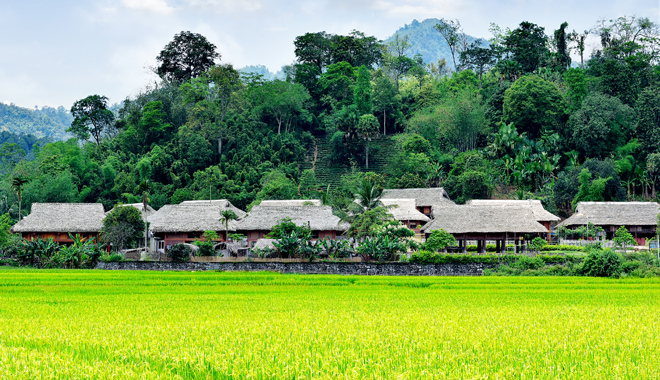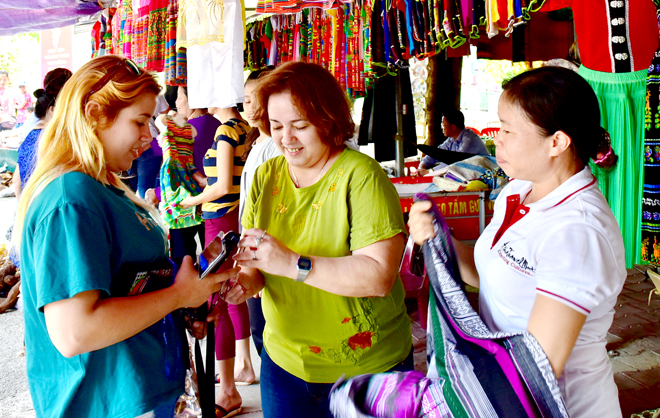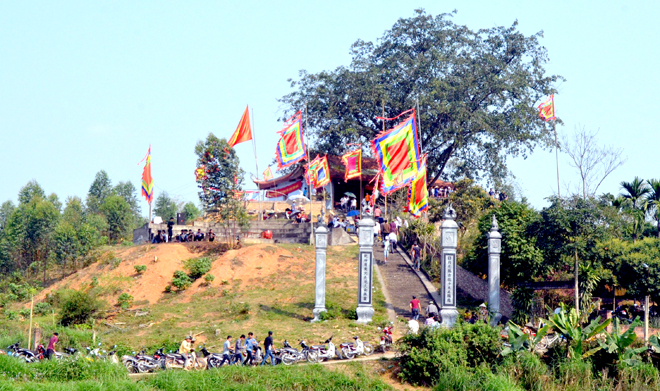
Tan Lap cultural village, Tan Trao commune, Son Duong district. Photo: Quang Hoa |
Son Duong has been well-known by pilgrims as the host location of Tan Trao Special National Relics, which was once served as the ‘Capital of liberated zone’ and ‘Capital of the resistance war’ where President Ho Chi Minh and leaders of the Party and State lived and worked during the resistance war. The site covers a number of vestiges attracting a large number of visitors, including Na Nua Shack, Tan Trao banyan tree, Tan Trao communal house, and Hong Thai communal house.
Realising its available advantages of historical, cultural and ecological tourism, the district’s authorities has invested in developing community-based and homestay tourism in Tan Lap cultural and tourism village, Tan Trao commune, drawing the participation of 13 local households. The 13 households were facilitated to join field trips to learn experience from several tourism models in other provinces and received training on cooking skills and tour-guiding skills. During their stay at the local residents’ houses, tourists are invited to enjoy traditional dishes prepared by host family. In addition, a 30-member art troupe was established to entertain tourists and deliver performances at festivals.

Tourists are buying souvernir at Tan Trao Special national historical relic, Son Duong district. |
Son Duong district is now home to 226 monuments, with 46 of them having recognised as national monuments and 84 others receiving provincial status. The district is also the host venue of many natural landscapes such as: Dong Bua Waterfall in Dong Loi commune, Dong Phai waterfall in Hop Thanh commune, as well as shrines, temples where assorted religious activities are practiced.
Since 2016, the district has mobilised businesses, organisations and individuals to open 10 additional accommodations, over 58 restaurants with a total investment of VND18 billion, increasing the total the number of accommodations and 20-seat-and above restaurants in the district to 33 and 120, respectively.
Efforts have also been made to restore and upgrade the architectural relics of Duc Ong temple in Son Nam commune, An Son temple of Hao Phu commune, Tay Thien pagoda, Van Phu commune; as well as preserve the celebration of traditional festivals such as the festival to pray for bumper crop at Tan Trao communal house, the festival to pray for luck at Hong Thai communal house, the festival to pray for longevity at Quang Tat communal house in Hoa Phu commune, and the Tho Vuc temple festival in Hong Lac commune. By the end of 2018, the district welcomed over 750,000 visitors and earned VND 570 billion in tourism revenue, equal to 104.9% and 100.5% of its annual target.

Festival of Tho Vuc temple in Hong Lac commune, Son Duong district which is held annually on the new year’s days, attracts a lot of tourists. Photo: Huy Hoang |
In a bid to turn potential into advantage, the district has designed a number of mechanisms and policies to encourage local tourism development and attract non-State sources for tourism activities. At the same time, the district has also worked to restore, preserve and upgrade historical and cultural relics, protect the natural landscapes and the environment, and uphold indigenous cultural identity.

Comment
Print